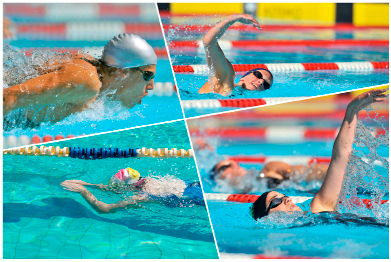Lesson 5: Graphing Linear Functions
Created by IMSreader
Module 5: Linear Functions
Lesson 5: Graphing Linear Functions
Focus

top left, top right, and bottom right: Christophe Schmid/iStockphoto/Thinkstock; bottom left: Veronika Surovtseva/iStockphoto/Thinkstock
There are four different techniques, or strokes, used in Olympic swimming. These are the butterfly stroke, the backstroke, the breaststroke, and freestyle. Each stroke requires a different way of moving the arms and a different way to breathe.
While most of the swimming events focus on one particular stroke, the medley events focus on all four! In the 200-m individual medley, each swimmer uses a different stroke for every 50 m of the race. The swimmers begin with the butterfly and end with the freestyle, or front crawl. The world record for both the 200-m and 400-m individual medley is held by Michael Phelps of the United States.
You have learned several ways of representing the equation of a linear function. These are the slope-intercept, general, and slope-point forms. In previous lessons you learned how to convert from one form to another.
In this lesson you will explore the strategies for using each form to graph linear functions. While you may not be breaking any world records, by the end of this lesson you will become more comfortable with different techniques for graphing lines. These techniques will come in handy in the remainder of this course.
Outcomes
At the end of this lesson, you will be able to
-> generalize and explain strategies for graphing a linear relation in slope-intercept, general, or slope-point form
-> graph, with and without technology, a linear relation given in slope-intercept, general, or slope-point form, and explain the strategy used to create the graph
-> match a set of linear relations to their graphs
Lesson Questions
-
In what ways can you verify that you have properly graphed a linear function?
-
How is graphing a linear relation similar to solving the corresponding equation?
 Lesson Completion and Assessment
Lesson Completion and Assessment
As you work through each lesson, complete all the questions and learning activities in your binder using paper and pencil, clearly labeling your work (they refer to this as your course folder). These include the Are you Ready, Try This, Share and Self Check questions. Check your work if answers are provided. Remember that these questions provide you with the practice and feedback that you need to successfully complete this course.
Once you have completed all of the learning activities, take the Lesson Quiz. This is the assessment for each lesson and is located under the Activities block on the left in moodle or under the Assess tab.
** Note – Share questions may have to be done on your own depending on your learning situation**